Home / History / Social History / Sino-Japanese Interactions Through Rare Books / Hayashi Razan’s works
This article is from the free online
Sino-Japanese Interactions Through Rare Books


Reach your personal and professional goals
Unlock access to hundreds of expert online courses and degrees from top universities and educators to gain accredited qualifications and professional CV-building certificates.
Join over 18 million learners to launch, switch or build upon your career, all at your own pace, across a wide range of topic areas.



 Fig.3 Razan Hayashi sensei-shū, Kanbun 2 (1662) printing
Fig.3 Razan Hayashi sensei-shū, Kanbun 2 (1662) printing Fig.4 Dōkanshō, printed book, first half of the 17th c.
Fig.4 Dōkanshō, printed book, first half of the 17th c. Fig.5 Kobun shinpō kōshū genkai taisei
Fig.5 Kobun shinpō kōshū genkai taisei Fig.6 Honchō ichinin isshu, Kanbun 5 (1655)
Fig.6 Honchō ichinin isshu, Kanbun 5 (1655)





